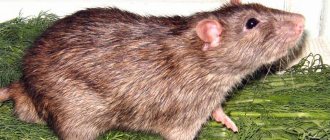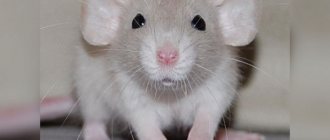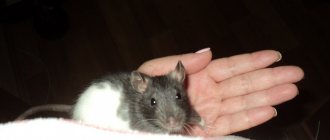Description
For many centuries, relations were established between humanity and these rodents, but they were not always warm. Thus, in the Middle Ages, rats contributed to the spread of severe plague epidemics, so they were exterminated.
In the last century, rodents began to be used for laboratory research, and only in the last few decades have people chosen rats as pets.
Did you know? Rats have truly amazing physical abilities: these relatively small animals are able to move at speeds of up to 10 km/h, in a state of stress or aggression, jump to a height of 2 meters and swim enormous distances (the record is 29 km). If necessary, the animal can cover a distance of up to 50 km within 24 hours.
The size of males on average ranges from 400-500 grams, especially large individuals can reach 800 grams, which is rare. Females weigh less - from 200 to 500 grams.
The character of boys and girls is different: males are more calm and flexible. You can pick them up and caress them without any problems. Girls are more active, restless, and playful. But in general, rats are quite calm and affectionate animals that will happily cuddle in the arms of their owner.
Some behavioral features of decorative rats:
- Rats love communication and attention, but they have a hard time with loneliness. If you don’t have the opportunity to spend enough time with your pet, you can buy a pair for him: they will be very funny to play and fool around with. By the way, to express gratitude for the company, rodents can lick the hair, fingers, and clothes of the owner. These gestures remind them of maternal care and affection.
- In a state of anxiety, fear, excitement, rodents can click their teeth. If an animal is very excited or frightened, it may hiss, causing the fur on its back to stand on end. In this state, the rat can attack an object that frightens it.
- If you keep several of these animals together, you will be able to observe the formation of a hierarchy between them in the form of a small fight. At the same time, there is no talk of serious bloodshed - the “showdown” is reduced to quiet squeals, sniffing and symbolic wrestling. But if you notice that the rats are fighting with cruelty, they need to be separated into different cages.
Important! In natural conditions, rats live only in a pack, so even an ornamental animal vitally needs communication with its fellows.
If you want to get a rat, you need to immediately take 2-3 same-sex pets, otherwise the animal will feel extremely bad when alone.
Broadbolk experiment
British Rothamsted Research is one of the oldest agrotechnical institutes in the world. It opened in 1843 as an experimental station, which immediately began a long-term research project. Initially, here, in the Broadbalk field, they tested how different fertilizers affected the yield of winter wheat, and planned to complete the work by 1841. But over time, the task became much broader, and to this day, wheat is grown year after year on the same field in Hertfordshire, England, studying the influence of a variety of factors on its growth, testing new fertilizers and pesticides. The care and patience of local biologists can be envied: for example, they spent a whole year assessing how different numbers of worms in the soil would affect the harvest.
Breeds of decorative rats
Decorative rats differ in color, coat length, and anatomical features. But there are no breeds of rats; only varieties can be distinguished, including:
- Standard. These pets are very easy to buy at a pet store and are the most common type of pet rat. They are distinguished by a smooth, glossy coat.
- Dumbo. People call these animals Mickey Mouse because of their external similarity: round, large ears set on the sides of the head.
- Downy ones.
- Sphinx - by analogy with cats with the same name: sphinx rats do not have hair. However, a small amount of hair is allowed in the groin, around the eyes, and on the ankles.
- Tailless. From the name it is obvious that the key feature of the species is the absence of a tail.
- Satin. The fur coat of animals of this species is characterized by shine, silkiness, and length.
- Double Rex. A very unusual species of rodent - due to the characteristics of its fur coat, this species is often called the undressing one. The animal has no fur in some places, and in some places it consists of areas of dense, curly hair.
Based on the color of their coat, decorative rats are divided into the following types:
- Homogeneous. They are characterized by a uniform coat color.
- Combined. The fur coat can be painted in several shades.
- Ticked. Each individual hair is colored in 2-3 colors.
- Silvery. There are two main tones in the coat color: white and silver.
Rodents are very popular as pets to keep squirrels, capybaras, degus, jerboas, guinea pigs, chipmunks, gerbils, hamsters, dormice.
Rat element Water
Quite a pleasant person, because the natural friendliness of the Rat is enhanced by the presence of Water.
The rat of the water element knows exactly what he wants from life, which cannot always be said about other brothers in the element.
If the object of her desire is you, then you will soon be surrounded by pleasant and slightly old-fashioned attention, roses and all the riches of the rat’s heart will come into your life.
The Rat of the Water element is brave and honest (as honest as a person born in the year of the Rat can be).
She will certainly try to make such a strong impression that you will lose ground under your feet and will soon find yourself in a position that most suits the rat with its rather ardent character.
Although the Water Rat demands attention, it is probably the easiest to fall in love with, as it has so many positive characteristics that sometimes they seem too good to be true.
In this case, we say that this is a person who is definitely capable of achieving success, although not to the same extent as some other Rats. But as compensation, he received charm and a sense of humor, which made life with him extremely interesting.
Never underestimate the strong intuition of the Water Rat and its poetic nature, which is more developed than that of ordinary rats.
It would be fair to say that the rat has a healthy temperament and does not tolerate fools. If you are ready to offer yourself to her without reserve, then you are unlikely to lose anything except your inhibitions. This person is worth getting to know better.
Lifespan
In general, decorative rats do not have a special life expectancy: on average, it is 2-3 years. Long-livers are considered to be individuals who have lived up to 4 years. However, an exceptional case has been documented when an ornamental rodent was able to live for more than 7 years.
How long decorative rats live at home is largely determined by the following factors:
- animal diet;
- accommodations;
- health status, timely seeking veterinary care;
- the presence of pregnancy in the female;
- living a rat alone or in the company of other rodents.
Important! Breeding domestic rats is a very difficult process that often ends in death for the female. For successful breeding, you need to select only the strongest and healthiest individuals of a strictly defined age: up to 8 months. In most cases, the female gives birth to many pups, and she herself may die.
Rat element Earth
- It is necessary to understand that all Rats are active, sociable and always on the way to something more. However, if there are exceptions to this rule in the Rat family, then they are among the Earth Rats, who by their nature are more cautious and constant.
- Of course, they are not deprived of the ability to achieve their own in life, characteristic of all representatives of the rat clan, although the earth rat will have to work longer and harder to achieve the desired goal.
- In addition, the Rat of the Earth element will enjoy the fruits of the success achieved longer.
- As for deeper relationships, they can only arise if you see the Rat often, and she is so busy with her work that she instantly disappears from this scene.
- Earth Rats are capable of sincerity and are less likely to betray you than other rats.
- They will be good parents, ready to happily create a happy family. Of course, none of this matters if you don't get to know the Earth Rat better, so I advise you not only to live, but also to work with her.
- This way, at least you will have the opportunity to talk to her from time to time, and she will understand you better. In general, this is a very positive person who will most likely be pleasant to have around.
Keeping decorative rats at home
Despite the compact size of the pet, this does not mean that you can neglect caring for your decorative rat. Like any pet, a domestic rat needs a certain diet, a place to live, and it is also worth considering the presence of other pets before getting a pet.
When purchasing a rat, you need to immediately think about where it will live. The only correct answer is a cell. For one individual, the size of the cage must be at least 30*50*40 cm; if the number of animals is larger, then the size of the dwelling increases. Interestingly, it is better for males to choose wider cages, and for girls - higher ones.
Do not load the cage with multi-story structures in the hope that the rat will find it more interesting. It’s better to build hammocks inside, put a couple of ladders, a wheel or a swing. The cage must have bedding: for example, made from sawdust (not pine wood!), you can also use corn or wood litter for cats or a special one for rodents.
As a budget option, you can take white paper, but not newspapers - rodents can be poisoned by toxic paint! The cage in which the animals live should be regularly removed, cleaned and the filler changed as necessary.
A prerequisite for proper maintenance of decorative rats at home is regular walking. While walking, remember a few important rules:
- put all valuable small items out of reach;
- many domestic rats like to chew and damage wires, so make sure that chargers, headphones and other equipment components are not left unattended;
- Make sure that all small animals are out of the animal's reach. Thus, these rodents are capable of attacking smaller rodents of other families, are able to climb into aquariums, and show aggression towards smaller animals.
With proper upbringing, there is a chance that a rodent will make friends with a domestic cat and dog, but you should not house rodents under the same roof with birds.
Important! Males and females must live exclusively in separate cells, otherwise uncontrolled reproduction and numerous offspring are guaranteed! Animals of different sexes also need to be walked at different times.
For a full-fledged existence, your pet needs to be provided with a balanced, literate diet. What can you give to decorative rats:
- vegetables (zucchini, pumpkin, beets, zucchini, carrots, cucumbers, bell peppers);
- greens (basil, cilantro, onion, parsley, lettuce, celery, dill);
- fruits and berries (apricots, pineapples, cherries, melons, strawberries, apples, plums, peaches);
- combined grain feed (millet, barley, oats, buckwheat, rice);
- gammarus, seafood (boiled);
- dairy products (cottage cheese, kefir, fermented baked milk, yogurt, cream);
- meat products (rabbit, poultry), including offal, but only in boiled form;
- chicken eggs and fish (boiled).
Based on the listed products, it is quite possible to create a varied diet for a rodent at home.
But despite all the diversity, there are categories of products that are harmful and dangerous for animals. So, what is forbidden to feed a decorative rat:
- sausage and other prepared meat products (they contain a lot of spices and additives);
- lard and deli meats;
- From dairy products you should avoid sour cream, butter and condensed milk . Regular milk should be given with caution, as there may be intolerance to it;
- the seeds from fruits and vegetables . They are difficult to digest and may contain substances harmful to the animal;
- citrus fruits are prohibited in the diet of rodents;
- Some fruits need to be given with caution and not overdo it: bananas, grapes, avocados, pears, kiwi. Some of them are too high in calories, while others contribute to gas formation;
- dried fruits should be supplied in very limited quantities;
- beans, beans and peas strongly stimulate gas formation, so they should be excluded from the diet;
- among vegetables you should avoid turnips, radishes and cabbage of all types;
- potatoes must first be thermally treated;
- It is strictly forbidden to give store-bought sweets, jam, honey, and baked goods .
The frequency of feeding depends on the age of the rats: young rats can be fed 3-4 times a day, adults need two feedings in the morning and evening hours.
Your pet must have a drinking bowl, the water in which is changed daily. It is also useful to place a stone in the cage to replenish calcium reserves. Did you know? Rodents have teeth that grow throughout their lives, so they urgently need to regularly grind them down on hard and tough objects.
These rodents are known for their cleanliness, so you don’t need to bathe them at all. In addition, some pets simply will not accept contact with water, although some rodents will gladly accept water procedures. There are situations in which an animal needs to be bathed regardless of its desire:
- if the animal is old and cannot fully care for itself;
- if the rodent is very dirty;
- if you haven’t cleaned the house for a long time, and the rat didn’t take care of itself carefully enough;
- if the animal has parasites that need to be removed.
Content issues
Keeping decorative rats has its own difficulties. Most often they are associated with the peculiarities of the lifestyle and habits of rodents. Problems that may arise:
- since in nature rats are most often nocturnal, pets often make noise at night;
- decorative rats have rather poor health, you need to be prepared for periodic visits to the veterinarian;
- domestic rats need constant attention and communication with the owner, otherwise they will become unbalanced and may even bite people;
- rats try everything, so when a pet goes for a walk around the house, it can chew wires, books, furniture, and things.
Tooth test
From time to time the rat needs to be released from the cage, but sometimes it is very difficult to ensure that the animal does not crawl into some opening, for example, into a ventilation shaft or the place where the network cable enters. If this happens, the pet may disappear forever into the bowels of the building.
Why have a rat at home?
Many people ask a similar question, because it is much more common to see a cat or dog next to you. However, rats are no less wonderful pets; they are very smart, affectionate, and will always welcome your attention. Caring for these animals is somewhat easier than for larger animals. However, keep in mind that some animals, due to their temperament, can engage in domestic pests.
Did you know? Rats are extremely fertile: one pair of animals can reproduce
offspring reaching 150-160 pups per year! In addition, these rodents have a gene that protects them from STDs.











